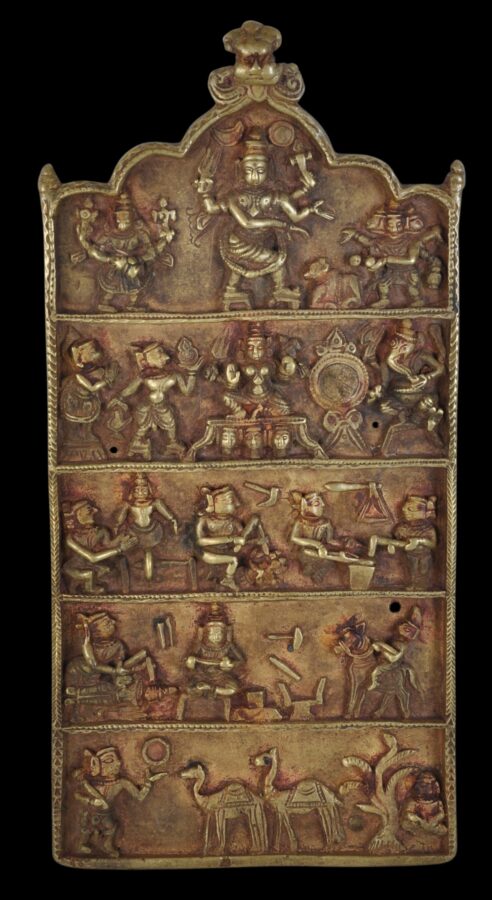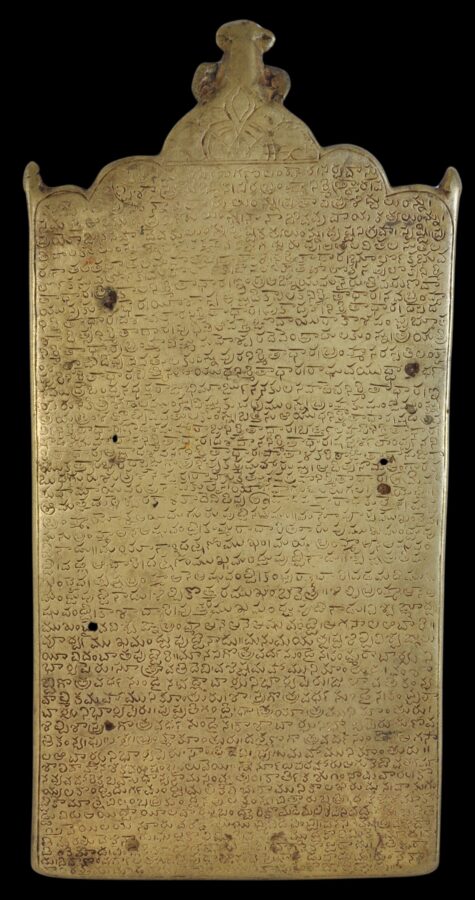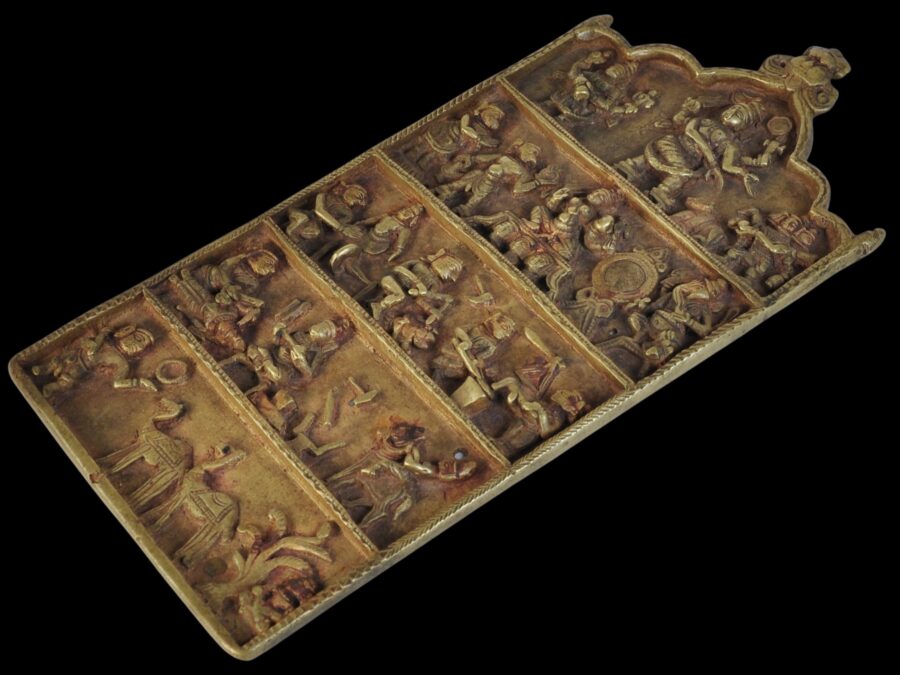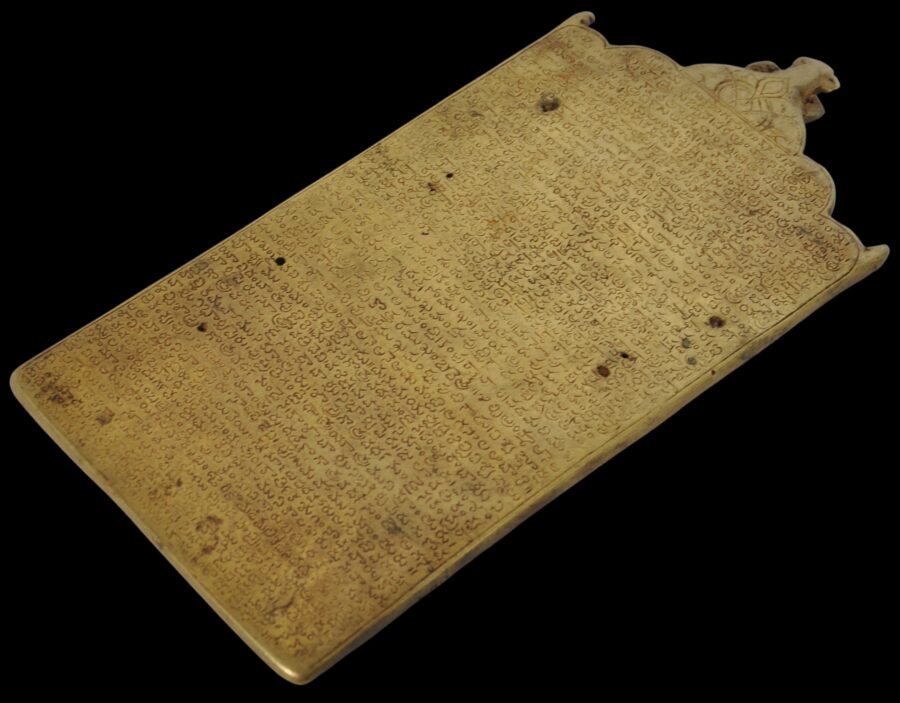Enquiry about object: 9623
Rare & Fine South Indian, Double-Sided, Brass Plaque Grant (Hakku Patra) Inscribed with Telugu Script
Andhra Pradesh, Deccan, Southern India dated samvat 1516 (AD 1572)
height: 27.2cm, width: 13.1cm, depth: 1cm, weight: 985g
Provenance
private collection; acquired in London, UK, around 2000
This is the finest Indian legal grant or hakku patra on metal that we have seen. Dating to the sixteenth century, it is of cast and finely worked brass with lines of Telugu script on both sides (a full translation is provided below.) Telugu is the main spoken language of what is now Andhra Pradesh state.
Of rectangular form, and with a cusped, arched top, on the front it is surmounted by a kirttimukha or protective mask, over five registers of scenes in high relief. The highest level shows a central figure of Shiva with Nandi at his feet, flanked by Vishnu and Brahma. The second tier is cast with a central figure of Durga, with three asura heads below, two devotees on the left, a figure of Ganesha and a mirror on the right. The middle tier has a scene of a sculpture workshop with craftsmen making images of a male deity and Brahma. A grinding wheel and an anvil are shown in use. The fourth tier shows a similar workshop scene, and includes a figure bringing an implement by horse. The lowest register shows two camels with what is probably a herder and a seated deity.
The reverse is densely and very finely inscribed with 52 lines of Telugu script. This comprises a mythical description of the origin of the Visvabrahmins or Visvakarmas, a community of artisans chiefly in the southern states of India. They see themselves as descendants and followers of Visvakarma, the Hindu god who is considered architect of the universe, and they are divided into five groups, each descending from one of Visvakarma’s five sons, comprising carpenters, blacksmiths, bell metalworkers, goldsmiths and stonemasons.
This mythological genealogy is provided as evidence of their entitlement, as proscribed by possession of the plaque, to practice their crafts.
A related, though less refined, example is in the National Museum, Delhi, and illustrated in Goswamy (2016, p. 83).
What is a hakku patra?
In India’s south, hakku patras were a legal grant or an entitlement for certain privileges, bestowed or endorsed by some authority, usually a local ruler, to an individual, group of persons, or caste or sub-caste, to own or use land, or to have some sort of exclusivity over the provision of services, usually occupational, such as the privileges that might be accorded to a guild.
The bestowal of such right has been common in India since ancient times. Extensive revenue and land grants were given to Brahmins but similar and other rights were given to almost every level of society. Artisans were give rights to operate in their field (to the exclusion of others) and even itinerant folk performers who might travel from village to village were granted such rights for specific geographic areas. Such a grant protected the holder from competition and allowed them to earn more income than they otherwise would.
Hakku patras sometimes were inscribed on paper but more usually were engraved on metal sheets (in which case they were in ragi rekula form) to emphasise their importance but also because the grants usually flowed from one generation to the next and so the enabling documentation needed to be in a permanent form. The importance of a hakku patra meant that such documents were kept safely and securely. Often their whereabouts was a secret known only by a trusted few.
Typically, a hakku patra did not just bestow a grant but also set out the recipient individual or community’s genealogy and historical rationale (apocryphal or not) as a means of demonstrating why the grant was warranted.
The example here is in excellent condition. It is finely cast and the engraved script is superb, so much so that it is largely legible which is unusual.
Below is a full translation of the text on both sides of this hakka putra, provided by Dr R. Thirmal Rao, director of the Andhra Pradesh Government Oriental Manuscripts Library and Research Institute, India:
Original: Svasti śrīmat guṇa gaṇa alaṅkāra Translation: May it be so! The one who is embodiment of all virtues
Original: Sarva vāstu śilpi śāstra sujñāna Translation: One who is the embodiment of all the knowledge of the science of architecture and Sculpture
Original: Parabrahma nirmita ādhāra Translation: and Supreme source of creation
Original: Paraṁ jyōti prasanna avatārulu nnu Translation: The incarnate of benevolent supreme light and
Original: Pratāpa prasid’dhulu nnu Translation: The one renowned for his valour and
Original: Samasta āyudha pravīṇulu nnu Translation: The one who is dextrous in weaponry and
Original: Nānā jīva vupāya kartalu nnu Translation: The one who is the creator of the various life forms and
Original: Prayōjana sahadēvakulu nnu Translation: The designated co-God and
Original: Sr̥ṣṭikartalu nnu Translation: The creator and
Original: Duṣṭa nigraha Translation: The destroyer of evil
Original: Sr̥ṣṭi pratipālakulu nnu Translation: The protector of the creation
Original: Śrī viśvakarma dēvara jagadguruvu Translation: Sri Lord ViSvakarma, the master of the universe
Original: Atala vitala sutala rasātala talātala mahātala pātāḷa nirmita ādhāra Translation: The creator of the atala, vitala, sutala, rasaatala, talaatala, mahaatala, paatala (the seven underworlds)
Original: Bhūlōka bhuvarlōka suvarlōka mahālōka janōlōka tapōlōka satyalōka nirmita ādhāra Translation: The creator of the (seven heavenly worlds) bhuuloka, bhuvarloka, suvarloka, maharloka, janoloka, tapoloka and satyaloka
Original: Trikāla nirmita ādhāra Translation: The creator of the three times (morning, day and evening)
Original: Indra agni yama nairuti varuṇa vāyuvya kubhēra īśān’ya aṣṭadikpālaka nirmita ādhāra Translation: The creator of the rulers of the eight directions, Indra, Agni, Yama, Nairuti, Varuna, Vayavya, Kubera, Isanya
Original: Navabrahma nirmita ādhāra Translation: The creator of nine brahmas (Creators)
Original: Daśa avatāra nirmita ādhāra Translation: The creator of the ten incarnations (of Lord Vishnu)
Original: Ēkādaśa nirmita ādhāra Translation: the creator of the eleven (Rudras)
Original: Dvādaśa āditya nirmita ādhāra Translation: The creator of the twelve Suns
Original: Pr̥thivī āpas tējas vāyur ākāśa pan̄ca bhūta nirmita ādhāra Translation: the creator of earth, water, fire, wind and sky (the five elements of nature)
Original: Brahma viṣṇu mahēśvara dēvēndra ādula kunnu Translation: To Brahma, Vishnu, Maheswara and Lord of the Gods and others
Original: Traya trinśat kōṭi divya dēvatala kunnu Translation: To the thirty three crores of divine gods
Original: Pura nirmita ādhāra Translation: the creator of the cities
Original: Brahma sarasvati laṅkāpuri nirmita ādhāra Translation: the creator of Brahma, Sariswati and the City of Lanka
Original: Battisu āyudha nirmita ādhāra Translation: the creator of the thirty two weapons
Original: Rāghava yud’dhārtha samudra bandhana dharmarāja bhīma arjuna nakula sahadēva nirmita ādhāra Translation: The creator of bridge for Raghava’s(Rama’s) battle and (also the creator of) Dharmaraja, Bheema, Arjuna, Nakula and Sahadeva
Original: Īśvaruniki triśūlamunnu viṣṇuku cakramunnu brahmaku ghaṇṭamu nnu traya trinśat kōṭi dēvatalakunnu battisu āyudha nirmita ādhāra Translation: The one who created Trident for Iswara, the Disc for Vishnu, the Stylus for Brahma and the creator of the thirty two weapons to the thirty three crores of gods
Original: Ṣaṭ cakravarti nirmita ādhāra Translation: The one who created the six emperors
Original: Ṣōḍaśa mahārāja nirmita ādhāra Translation: The one who created the Sixteen kings
Original: Bartulahari??? Nirmita ādhāra Translation: the one who created the greatwave???
Original: Trikāla nirmita ādhāra Translation: the creator of the three times (morning, day and evening)
Original: Indra agni yama nairuti varuṇa vāyuvya kubhēra īśān’ya aṣṭadikpālaka nirmita ādhāra Translation: the creator of the rulers of the eight directions, Indra, Agni, yama, Nairuti, Varuna, Vayavya, Kubera, Isanya
Original: Navabrahma nirmita ādhāra Translation: the creator of nine Brahmas (Creators)
Original: Daśa avatāra nirmita ādhāra Translation: the creator of the ten incarnations of Lord Vishnu
Original: Ēkādaśa nirmita ādhāra Translation: the creator of the eleven (Rudras)
Original: Dvādaśa āditya nirmita ādhāra Translation: the creator of the twelve Suns
Original: Pr̥thivī āpas tējas vāyur ākāśa pan̄ca bhūta nirmita ādhāra Translation: the creator of the five elements of nature: earth, water, fire, wind and sky
Original: Brahma viṣṇu mahēśvara dēvēndra ādula kunnu Translation: To Brahma, Vishnu and Maheswara and the other gods
Original: Traya trinśat kōṭi divya dēvatala kunnu Translation: To the thirty three crores of divine gods
Original: Pura nirmita ādhāra Translation: the creator of the cities
Original: Brahma sarasvati laṅkāpuri nirmita ādhāra Translation: the creator of Brahma, Saraswati and the city of Lanka
Original: Battisu āyudha nirmita ādhāra Translation: the creator of the thirty two weapons
Original: Rāghava yud’dhārtha samudra bandhana dharmarāja bhīma arjuna nakula sahadēva nirmita ādhāra Translation: The creator of bridge for Raghava’s(Rama’s) battle and also the creator of Dharmaraja, Bheema, Arjuna, Nakula and Sahadeva
Original: Īśvaruniki triśūlamunnu viṣṇuku cakramunnu brahmaku ghaṇṭamu nnu traya trinśat kōṭi dēvatalakunnu battisu āyudha nirmita ādhāra Translation: The one who created Trident for Iswara, the Disc for Vishnu, the Stylus for Brahma
Original: Ṣaṭ cakravarti nirmita ādhāra Translation: The one who created the six emperors
Original: Ṣōḍaśa mahārāja nirmita ādhāra Translation: The one who created the Sixteen kings
Original: Bartulahari??? Nirmita ādhāra Translation: the one who created the greatwave???
Original: Ṣōḍaśa mahādāna nirmita ādhāra Translation: The creator of sixteen great charities
Original: Daśadāna nirmita ādhāra Translation: the creator of ten charities
Original: Ṣaṭ darśa??? Lān̄chana nirmita ādhāra Translation: The creator of six visual??? signs
Original: Aṣṭādaśa varga??? Nirmita ādhāra Translation: the creator of eighteen stratifications
Original: Pātāḷa karirājatā??? Sujavāyu kartāra Translation: underworld elephant_king??? benign_air??? agent???
Original: Bharadvāja gōtra Translation: Descendant of BharadvAja
Original: Nitya karma mahāruṣya Translation: The great sages??? who perform the daily rituals
Original: Āditya sōma aṅgāraka budha guru śukra śanaiścara rāhu kētu nava graha nirmita ādhāra Translation: The creator of the Navagrahas (the nine planets) the Sun, the Moon, the Mars, the Mercury, the Jupiter, the Venus, Saturn, rAhu and ketu.
Original: Śrī mahāruha māya vara prasādakulaisa yōga vāgambulu gala yeṭṭi śrīmat kamaṭhēśvara kāḷikā dēvi divya śrī pāda padma ārādhakulaina pan̄ca brahma yokka ayiduguru puṭṭina kramaṁ Translation: The order of the birth of the panchabrhmas (Five Brahmas), the ones who are bestowed with the grace of Maharuha mAya and endowed with yoga and the speech, the worshippers of the lotus feet of Srimat KamaTeswara kalikadevi
Original: Manō pūrva mukhan̄caiva manu brahma anē aṣuvaṇṭi kam’marācāri tūrupu mukhamandu puṭṭināḍu Translation: Since, the Blacksmith, also called as Manu Brahma is in the east, Manu brahma is born on the eastern side.
Original: Mayānāṁ dakṣiṇamukhaṁ maya brahma anē aṣuvaṇṭi vaḍla ācāri dakṣiṇamukha mandu puṭṭināḍu Translation: Since, the Carpenter also known as Maya is in the south, Maya brahma is born on the southern side.
Original: Tvaṣṭa pratimukhan̄caiva tvaṣṭa brahmaṁ anē aṣuvaṇṭi kan̄c’harācāri paḍamaṭi mukhamandu puṭṭināḍu Translation: Since, the Coppersmith also known as Twashta is in the west, Twshta brahma is born on the western side.
Original: Śilpikōttaramukhaṁ bhavatē Translation: (Since,) the Sculptor also known as Silpika is in the north(,) (Silpi brahma is born on the northern side)
Original: Viśvajña ūrdhvamukhan̄caiva viśvajña brahmaṁ anē aṣuvaṇṭi agasāla ācāri vūrdhvamukhamandu puṭṭināḍu Translation: Since, the Goldsmith also known as ViSvajna is on the top, viSvajna brahma is born on top.
Original: Manu maya tvaṣṭa śilpi viśvajñulu Translation: (the five brahmas) Manu, maya, twashta, silpi viswajnas
Original: Manō pūrva mukhan̄caiva manu brahma anē aṣuvaṇṭi kam’marācāri tūrupu mukhamandu puṭṭināḍu Translation: Since, the Blacksmith, also called as Manu Brahma is in the east, Manu brahma is born on the eastern side.
Original: Mayānāṁ dakṣiṇamukhaṁ maya brahma anē aṣuvaṇṭi vaḍla ācāri dakṣiṇamukha mandu puṭṭināḍu Translation: Since, the Carpenter also known as Maya is in the south, Maya brahma is born on the southern side.
Original: Tvaṣṭa pratimukhan̄caiva tvaṣṭa brahmaṁ anē aṣuvaṇṭi kan̄c’harācāri paḍamaṭi mukhamandu puṭṭināḍu Translation: Since, the Coppersmith also known as Twashta is in the west, Twshta brahma is born on the western side.
Original: Śilpikōttaramukhaṁ bhavatē Translation: Since, the Sculptor also known as Silpika is in the north, Silpi brahma is born on the northern side.
Original: Viśvajña ūrdhvamukhan̄caiva viśvajña brahmaṁ anē aṣuvaṇṭi agasāla ācāri vūrdhvamukhamandu puṭṭināḍu Translation: Since, the Goldsmith also known as ViSvajna is on the top, viSvajna brahma is born on top.
Original: Manu maya tvaṣṭa śilpi viśvajñulu yūvidhan̄cāta puṭṭiri Translation: The five Brahmas Manu, maya, twashta, silpi viswajna are born in this order
Original: Mānasa gōtra vardhanuṇḍaina kaṇḍurācāryuni bhārya pēru sūtrāvatidēvi Translation: Sutravatidevi is the name of the wife of Kanduracharya, the progenitor of Manasagotra
Original: Vaśiṣṭamahāmuni kūturu Translation: (is) the daughter of great sage VasiShta
Original: Vanśābdhi gōtra vardhanuṇḍaina vaḍlācāryuni bhārya pēru jalāvatikan’ya Translation: Jalavati kanya is the name of the wife of Vadlacharya, the progenitor of Vamsabdhigotra
Original: Vālmīki mahāmuni kūturu Translation: (She is) the daughter of the great sage Valmiki
Original: Śāstra gōtra vardhanuṇḍaina kan̄carācāryuni bhārya pēru puṣpātigandhi Translation: Pushpatigandhi is the name of the wife of kancharacharya, the progenitor of sastra gotra
Original: Dhātrayātra muni kūturu Translation: (She is) the daughter of the sage Dhatrayatra
Original: Śilpiśāstra gōtra vardhanuṇḍaina kāḷācāryuni bhārya pēru guṇavatikan’ya Translation: Gunavatikanya is the name of the wife of Kasacharya, the progenitor of Silpisastra gotra
Original: Pulaśyabrahma kūturu Translation: (she is) the daughter of poulastya brahma
Original: Dakṣaṇa gōtra vardhanuṇḍaina agasāla’ācāryuni bhārya pēru saundridēvi Translation: Soundridevi is the name of the wife of agasalacharya, the progenitor of Dakshinagotra
Original: Bhr̥gumahāmuni kūturu Translation: (She is) the daughter of great sage Bhrigu
Original: Śālivāhana śaka varuṣambulu veyinnonūrlu padahāru agunedi vartamāna vyavahārika bahudhān’yanāma sanvatsara kārtika śu 10 sōmavāraṁ. Translation: Monday the tenth day (Suddha Dasami) of kartika masa in the year one thousand five hundreds and sixteen (1516) of the name bahudhanya of the Satavahana era
Original: Koyyalakoṇḍa durgamandu malikivibhurāmuni kāla biruduna. Translation: during the rule of Malkivibhurama of the Koyyalakonda fort
Original: Pānugaṇṭi kāmākṣi bilaṁ badri kundanapu lakṣmanna cittāru badri dhavaḷēśamākonaṇḍu viru ayiddāyīlavāru baṇḍāri komaḍi maliśeḍini daḍḍa śakambulaitē 12 veyilayenūru. Translation: Panuganti kamakshi(,) bilam badri(,) kundanapu lakshmanna(,) Cittaru badri(,) Dhavalesamakonadu their five kinsman Bandari(,) Komadi(,) Mali(,) Sedini(,) Dhadda in the era 12 one thousand five hundred (1500).
References
Goswamy, B.N., The Word is Sacred, Sacred is the Word: The Indian Manuscript Tradition, Niyogi Books, 2006.
Rao, T., ‘Study and collection of Hakku Patras and other documents among folk communities in Andhra Pradesh’, Endangered Archives Program, British Library, 2009.






